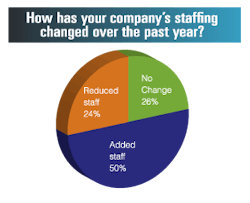"Material handling is no longer just lifting boxes and driving forklifts. It is much more complex and the compensation does not match the knowledge and skill level required. Most company executives do not understand the role material handling plays in the operation and the financial impact it has on the company's bottom line.”—logistics manager with an industrial products manufacturer with more than 40 years of experience, living in the Pacific region and earning $120,000
"I believe customers will continue to look for new ways to reduce costs associated with material handling, and thus our industry will see continued growth and much interest in new technology in years to come.”—corporate/executive manager with a material handling equipment manufacturer with 31-35 years of experience, living in the South Atlantic region and earning $95,000
"Material handling and logistics is not an attractive career choice that has people knocking down doors to join. Companies need to do more to keep the loyalty of their employees, as I feel we are going to see an exodus of good workers leave this field over static pay and no room for advancement.”—purchasing manager with a material handling equipment manufacturer with 16-20 years of experience, living in the North Central region and earning $65,000
"I'm satisfied with my salary and job situation. I have a broad range of responsibilities and am empowered to do my job.”—corporate/executive manager with a paper/printing company with 36-40 years of experience, living in New England and earning $150,000
This year's survey, we should note out the outset, was conducted in December 2016-January 2017—in other words, after the election, but before Donald Trump was inaugurated. So the survey results should not be taken as any kind of referendum on the job President Trump is doing, but rather as an indication of what many of your peers have experienced over the past year, and how they view their prospects for the immediate future.
One key question we ask every year is, "How satisfied are you with material handling and logistics as a career?” In 2016, 79% said they were either satisfied or very satisfied; in 2017, that number dropped by 4 points to 75% (however, we should also note that in 2015, the number was 74%). Similarly, we asked, "How satisfied are you with your current job?” This year, the number of satisfieds and very satisfieds added up to 72%. In 2016, that number was 73%, and in 2015 it was 71%. So, if nothing else, we can say with confidence that roughly 7 out of every 10 material handling and logistics managers are relatively happy with their chosen professions and current jobs.
Every year, we develop a profile of what the "typical material handling and logistics manager” looks like, and the profile hardly changes from year to year (proving if nothing else the validity of our survey methodology). This archetypal manager is a white male in his 50s, living in the Midwest with 20 years of experience in the industry, and working for a manufacturer of material handling equipment. He has a C-suite position in corporate management, has worked at his current company for 6-10 years, has a four-year college degree, received a raise last year between 1-3% and anticipates a raise between 1-3% in 2017, and did not receive a bonus last year. And his annual salary is $97,526, which is down $914 from the previous year's average salary of $98,440—another reason, perhaps, why job satisfaction dipped somewhat in 2017.
From Sea to Shining Sea
"Our pool of qualified candidates in our geographic area is presently shrinking. This adversely affects our overall quality and ability to maintain and increase our growth potential.”—plant manager with a chemicals manufacturer with 31-35 years of experience, living in the Middle Atlantic region and earning $83,000
"Unfortunately we as a society do not promote the trades in the New England region as they do in other parts of the country. This causes an exodus from the region and also costs of living to rise.”—operations manager with a material handling equipment manufacturer with 31-35 years of experience, living in New England and earning $57,000
"Working for the state I don't expect the highest wage since we have other benefits. However, I still think that we are underpaid, compared to other states and universities.”—purchasing/procurement manager with a university with 11-15 years of experience, living in the Mountain region and earning $56,000
"I'm currently working in upper state New York but my home is in Connecticut. No jobs in Connecticut.”—supply chain director with a medical device manufacturer with 36-40 years of experience, living in the Middle Atlantic region and earning $150,000
There's no magic formula behind how much a material handling and logistics manager gets paid. If you pore through the charts, the patterns of salary escalation become obvious:
- Older people tend to make more than younger, and the more experience you have in your company and your industry, the better you'll be paid.
- The more education you have, the more you'll make at your job.
- Corporate and senior executives make more than departmental managers.
But one category that seems to be among the most popular (maybe because it seems to hold some hidden secret) is the geographic location of the respondents. Why, for instance, is the South Atlantic region of the country the lowest paid? Or why are the average salaries so much higher in the Pacific region?
First, keep in mind that each person's salary is specific to what he or she does, what type of company they work for, and the demand for that particular skill set in that part of the country. Then, take a closer look at the regions. The South Atlantic, for instance, includes many right-to-work states whose industries are not heavily unionized. Three states in the region--South Carolina, North Carolina and Georgia--are among the four states with the lowest union membership (with Utah being the other), according to the Bureau of Labor Statistics. The Pacific region, on the other hand, includes California, almost a separate country unto itself when it comes to regulations and having by far the largest representation of union members among the 50 states.
Cost of living is another important consideration. Yes, material handling and logistics managers tend to make more in the Middle Atlantic states than, say, the Mountain states. But there are also twice as many managers in the Middle Atlantic region, and many of them are employed in New York, where the cost of living is far higher than it is in Idaho. So before you start thinking about packing up and moving for a bigger paycheck, check out some online real estate listings to see how much it would cost to find another house like the one you've got in another part of the country.
It's Still a Man's World
"I feel there are still some barriers because of being a female. I feel as if I am not always taken seriously or seen as an important part of the business.”—distribution/logistics manager with an automotive manufacturer with 6-10 years of experience, living in the North Central region and earning $95,000
"There is a need for more women.”—corporate/executive manager at an industrial products manufacturer with 21-25 years of experience, living in the North Central region and earning $195,000
The news isn't all bad, though, as these numbers actually represent considerable progress over the past year. In the MH&L 2016 Salary Survey, men held 90% of all managerial positions and earned $101,449.
Women, on the other hand, held 10% of the jobs and earned $70,466. So the trend points to women gaining 5% more of the managerial slots over the past year, and increasing their average salary by a bit less than $9,000 (the average salary for men, in comparison, dropped by $758). So, while the discrepancy between the genders is still, frankly, embarrassing and atrocious, the situation did improve a bit since last year's survey.
According to a "women in supply chain” study conducted by Gartner and AWESOME (Achieving Women's Excellence in Supply Chain Operations, Management & Education), the percentage of women in leadership positions decreases as the corporate ladder rises. Industrial manufacturers in particular have noticeably lower representation than other sectors, such as healthcare, retail and telecommunications. And fewer than half (47%) of survey respondents say their companies are actively working towards attracting, retaining and promoting more women into supply chain leadership roles.
"One of the most surprising findings is that although there is a general perception that women are gaining higher levels of leadership in supply chain, the survey found that actual progress is much slower than that perception would suggest,” notes Nancy Nix, executive director of AWESOME.
Where Have All the Workers Gone?
"Manufacturing in the U.S. has been contracting over the last 15 years. As a result, it is difficult to find motivated employees with the necessary skill sets willing to work.”—purchasing manager with a consumer goods manufacturer with 26-30 years of experience, living in the South Atlantic region and earning $68,000
"With more government regulations it is getting harder for drivers to make the kind of money they are used to getting so a lot of them are leaving. Even in the maintenance department the employees don't like all of the regulations and electronics they have to keep up with.”—maintenance manager with an automotive manufacturer with more than 40 years of experience, living in the South Central region and earning $110,000
"It is difficult to get labor for this field. Robot automation is the trend now in order to overcome the labor shortage and high wages.”—business development manager with an industrial machinery manufacturer with 11-15 years of experience, living in the Pacific region and earning $120,000
Here's a small sampling of the talent-related responses we received:
- "Finding, hiring and keeping good quality, reliable, dependable and safe workers.”
- "Getting qualified employees who want to work consistently.”
- "Onboarding talent at reasonable rates.”
- "Hiring new employees with a good work ethic. The current generation is more interested in social media than working.”
- "Training and development of people—either new hires or current staff.”
- "Finding quality people who find this industry challenging and rewarding.”
"Top-tier talent is a core factor in the success of any company,” explains Dan Charney, president and CEO of Direct Recruiters Inc. (DRI), an executive search firm for companies specializing in material handling and logistics, "yet there is an insufficient talent pool from which to acquire leadership. This labor shortage is causing those on the front lines to talent poach from competitors. Right now, the competition for highly qualified and experienced leaders is at an all-time high due to several factors, including an underinvestment in leadership development and tighter operating margins that influence workforce strategies.”
For better or worse, the Baby Boomer generation will eventually have to hand off the future of the material handling and logistics industry to the younger generations—Generation X, the Millennials and even the next group to come (which some are calling Post-Millennials, for want of a better term). Just four years from now, half of all the workers in the labor force will be Millennials.
While that thought might give you the night sweats, keep in mind that despite all the challenges the Millennials present to senior managers, they're also the ones who understand and, in many cases, have developed and enhanced most of the disruptive technologies that dominate the supply chain arena, from delivery drones to wearables to warehouse robots to the Internet of Things. And not only aren't Millennials apprehensive of these changes, but they tend to enthusiastically embrace them. As one respondent pointed out, we're in a transitional phase between old-school thinking and a new, clearer vision of the world to come. How our companies arrive at that new world is up to each of us, but having a good blend of experience and creativity certainly will pay off in both the short- and the long-term.
-----------------------
The Method to Our Madness
The MH&L 2017 Salary Survey was conducted online via e-mailed invitations to a select group of subscribers. The survey took place in December 2016-January 2017, with 488 responses. Respondents were not compensated, but were offered the opportunity to share their opinions and insights related to their jobs and their industry. All responses were anonymous.
The Rest of the Story
Go online to MH&L's Annual Salary Surveys to find even more salary figures and charts from the MH&L 2017 Salary Survey, including a slideshow gallery of tables detailing responses to questions not featured in this print edition. You can read hundreds of open-ended comments from respondents about the biggest challenges confronting supply chain managers; the one thing they would like to change about their jobs; and their observations about the industry and their role within it. You can also access salary survey results from previous years, as well as related articles and commentary focused on workforce issues within the industry.







